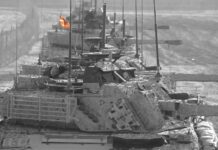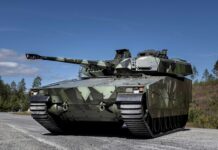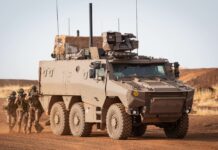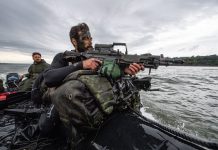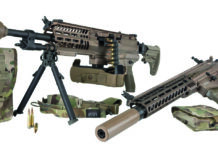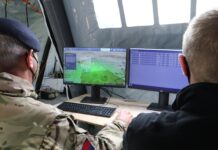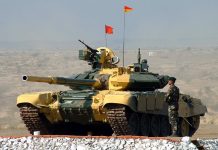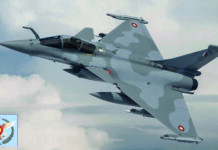There was a time when it was considered perfectly acceptable to equip a Light Armoured Vehicle (LAV) with a rifle-calibre machine gun, assuming that such a weapon was perfectly adequate to support dismounts from an APC, or for a reconnaissance vehicle that was supposed to avoid being embroiled in combat. Today such thinking is a thing of the past.
Current thinking is that the top end of the medium-calibre cannon category is the wave of the future. When it became clear to that the rifle-calibre machine gun was not really viable as a vehicle weapon, the next step was the move to the heavy machine gun. For the pro-Western camp this translated into the usage of the 12.7x99mm M2HB Browning, initially on pintle mounts and then in a host of different turret options. For the Soviet camp, the answer was the 12.7x108mm DShk and then they moved on to use the 14.5x114mm KPV, with the later weapon being used on the BRDM-2 reconnaissance vehicle and the BTR-60/-70/-80 series of wheeled armoured vehicles.
While the 12.7mm and 14.5mm where, and still remain in many applications, very useful they were not an optimum solution. The reason for this was very simple – the performance of these systems was well known and therefore providing vehicles with suitable protection was not that much of a challenge. As an example, the basic protection level for the British WARRIOR Infantry Fight Vehicle (IFV) that entered service in 1987 was that it be proof against Soviet 14.5mm. Others decided that it made more sense to go beyond the 12.7/14.5mm stage and provide light armour with a cannon armament and thus make the move to medium-calibre cannon.

Of course the move from the rifle-calibre machine gun to the heavy machine gun and then on to the medium-calibre cannon was not the straightforward logical progression that might be implied. Different philosophies led armies along different paths, added to which there were the cost factors involved in equipping light armour with higher performance and therefore more expensive weapons. For example, the US Army was prepared to deploy the M2HB heavy machine gun on the majority of its light armour, initially covering both wheeled and half-tracked vehicles. With the introduction of the tracked APC in the form of the M75, succeeded by the M59 and eventually the M113, which arrived in the early 1960s, the M2HB remained the weapon of choice although combat experience in Vietnam led to US to develop protected weapon stations for the M113.

It was only with the arrival of the M2 BRADLEY IFV equipped with the 25mm M242 cannon in 1981 that the US would move beyond the heavy machine gun towards the medium-calibre cannon. Others had already looked beyond 12.7mm HMG vehicle armament, for example Germany. The Bundeswehr adopted the Hispano-Suiza Schützenpanzer Lang HS.30; this had entered service in 1960 with the vehicle having a turret mounting an HS-820 20mm cannon. The Swedish Pansarbandvagn 301 (pbv 301) APC that entered service in 1961 was equipped with a Bofors 20mm m/45 cannon on a remote mount operated from within the vehicle.
Reaction and Response
Conventional thinking on the issue of the IFV versus the APC and what weapon systems they should be equipped with was challenged by the arrival of the BMP-1 in the mid-1960s. This was certainly something different. Its turret was equipped with a 73mm 2A28 smoothbore low pressure gun, a 7.62x54mm PKT co-ax machine gun and a launcher for the 9M14 MALYUTKA (AT-3 SAGGER) anti-tank missile. By the standards of the time that was a lot of firepower for a small (13 tonne) vehicle and one which was, superficially at least, rather well protected.
In many respects the BMP-1 was a false dawn as far as the IFV was concerned. The 2A28 was disappointing in terms of range and power, while the vehicle itself proved deficient in terms of protection. The end result was the arrival of the BMP-2 at the start of the 1980s. This offered better protection and the main armament was changed to a 2A42 30x165mm cannon. The 2A42 is a dual-feed system commonly utilising AP-T and HE-T rounds, though an APDS nature is also available. The rounds for the standard 2A42 are percussion primed, while variants of the system used for airborne and naval applications are electrically primed.
The 2A42 remains the standard Russian medium-calibre cannon for armoured vehicle applications, being used in the BMP-2, BMD-2, BMD-3, BTR-80A and the BMPT. It is also standard fit on the next generation of Russian armour such as the KURGANETS IFV, the BUMERANG wheeled vehicle and the T-15 heavy IFV. The 2A72 variant of the 2A42 cannon is also in service on the BMP-3 IFV and on the BTR-82 APC. As the BMP-2 was sold so widely, ammunition is available from multiple sources apart from Russia. Mecar in Belgium, a subsidiary of Nexter, produce the M929 APFSDS-T round for the 2A42 to meet the demand for better penetration characteristics than the standard AP round offered for the 2A42.
In Germany the search for a true IFV system had seen the development of the MARDER, which entered service at the start of the 1970s. The turret is equipped with a 20x139mm Rh-202 cannon, and vehicle protection levels are good as is mobility. The original MARDER was to be replaced by the MARDER 2 at the end of the 1980s; the new vehicle would have been heavier and better protected, with enhanced firepower. This was an expensive vehicle and that fact plus the end of the Cold War marked its demise.
The successor vehicle to the MARDER in the German military is the PUMA produced by PSM, a joint venture of KMW and Rheinmetall. The first PUMA vehicles were delivered to the Bundeswehr on 24 June 2015 and the last of the 342 vehicles on order will be delivered in 2021. PUMA is a major advance on the previous generation MARDER vehicle, offering increased mobility, increased protection (protection levels are scalable to match the threat environment) and firepower. The PUMA is equipped with a Rheinmetall 30x173mm MK-30/2 ABM cannon in an unmanned turret; there is a complete range of ammunition available for this cannon including APFSDS-T, KE-TF (air burst), PELE(penetrator with enhanced lateral effect) and FAPDS (frangible) natures.
The MK-30 cannon is also in use with the ASCOD IFV used as the ULAN in Austria and the PIZARRO in Spain, and in the BOXER Combat Reconnaissance Vehicle (CRV) selected by the Australian Army for its Project LAND 400 Phase 2 requirement, in this application the cannon is installed in the Rheinmetall LANCE turret. Another BOXER customer is Lithuania, but they selected a different armament option for their vehicles in the form of the Rafael SAMSON Mk II Remote Weapon Station mounting the Northrop Grumman MK 44 BUSHMASTER II 30x173mm cannon.
The BUSHMASTER II is a development of the 25mm M242 cannon as used in the M2 BRADLEY, and is used in ground, air and naval applications. Ammunition types include the Mk264 MPLD-T (multipurpose low-drag tracer), Mk266 HEI-T, Mk238 HEI-T/SD, Mk239 TPT-T, Mk258 APFSDS-T, Mk320 APDS-T and the Mk317 TPDS-T. Further growth for the MK 44 features the addition of an airburst munitions capability allowing the utilisation of the Mk310 PABM-T programmable airburst nature.
This weapon has been widely adopted internationally; it is on the CV9030 operated by Finland, Norway and Switzerland, the PANDUR II operated by Czech Republic and Portugal, Singapore’s BIONIX II and HUNTER IFV, the ROSOMAK in Poland, and on the PIRANHA vehicles operated by Ireland and Romania. More recently it has been acquired by Spain for its DRAGÓN (PIRANHA V) vehicles.
The BUSHMASTER II has also entered service with the US Army in the XM813 variant that features an extended barrel to support the use of programmable airburst munitions (Mk310), the weapon in mounted on the Kongsberg PROTECH MCT-30 unmanned turret which is integrated with the STRYKER vehicle. Initially it was decided to upgrade some 83 STRYKER vehicles in service with the 2nd Cavalry Regiment based in Germany, with the upgraded vehicles being classified as the Infantry Carrier Vehicle DRAGOON (ICVD).
The MCT-30/XM813 combination is known as the Medium Calibre Weapon System (MCWS) to the US Army and after evaluating the performance of the ICVD system it was decided to embark on a STRYKER upgrade programme to fit the MCWS. However, integration of the MCWS would only be carried out with the vehicles that had undergone the Double-V-Hull (DVH) upgrade to improve protection against mines and IEDs, and these vehicles are classified as the DVHA1 ICV. The US Army plans to upgrade three STRYKER brigades equipped with the DVHA1 ICV with the MCWS.

Other Approaches
The British Army had come to the conclusion in the 1960s that its future light armour would require a medium-calibre cannon, to provide the necessary level of firepower. At that time consideration was given to having light armour equipped solely with an anti-tank missile armament, but this was rejected due to the long time-of-flight of such weapons and their cost, not to mentioned their unreliability. Another possibility was a recoilless weapon. Again, this was rejected due to operational and performance limitations. This left the medium-calibre cannon with a calibre of between 20mm and 40mm as the only plausible solution for light armour.
It was decided that 30mm was the appropriate calibre and there was a great deal of interest in adopting the Hispano-Suiza Type 831SLM cannon for the requirement. The problem was that the Type 831 did not have the characteristics that the British necessary for a turret mounting on light armour, the trunnion pull was too high and the long inboard length of the gun took up too much real estate in the turret. This resulted in the design of a new gun in the form of the 30x170mm calibre L21A1 RARDEN, the calibre was selected in order to utilise the full range of existing Type 831 ammunition, in addition the British also developed a new APDS round for the gun.
Requirements for the RARDEN were the destruction of light armour at any angle at a range of 1,000 metres and penetration of the side armour of a main battle tank, engagement of soft-skin vehicles of troops in the open or behind light cover and deterring aircraft or helicopters flying at low level. Vehicles fitted with the RARDEN were the FV721 FOX 4×4 reconnaissance vehicle (retired), the FV107 SCIMITAR tracked reconnaissance vehicle, still in service with the British Army in the upgraded Mk 2 version, and with Latvia, and finally with the FV510 WARRIOR.
The era of the RARDEN in the British Army is coming to an end as new vehicles and medium-calibre cannon will be introduced. The SCIMITAR is due to be replaced by 2026 by the AJAX reconnaissance vehicle, part of the acquisition of 589 SCOUT Specialist Vehicles (SV) from General Dynamics Land Systems-UK. While the WARRIOR fleet is to be upgraded under the WARRIOR Capability Sustainment Programme (WCSP). One common feature of AJAX and WCSP is that both will see the introduction of a new cannon in the form of the 40 mm Cased Telescoped Armament System (CTAS).
In 1994, BAE Systems and Nexter formed a joint venture company CTA International, based at Bourges in France, to develop the CTAS. British interest in the CTAS came from the fact that they recognised that they would need a new medium-calibre cannon that offered more hitting power, increased range and ammunition that offered a much broader target engagement profile. This would a larger calibre compared to the RARDEN, but, in comparison to conventional cannon systems, the CTAS and its ammunition would occupy far less turret real estate.
By the mid-2000s, the British had been investing in the CTAS for some time and were looking at it to equip an upgraded WARRIOR. They looked to bring competition into the upgrade via an evaluation of competing turret solutions from Italian and US suppliers both utilising the BUSHMASTER II cannon. This demonstrated that the CTAS was the way forward, although progress on the programme would be slow due to issues with vehicle programmes. Eventually, matters became clearer, there were two programmes in the form of a new vehicle, AJAX, and an upgrade, WARRIOR WCSP, and in 2015 this led to a British order for 515 CTAS weapons, 245 for each vehicle and 25 for testing, qualification and spares use.
France was also developing a new armoured vehicle, in this case to replace the AMX-10RCR, ERC-90 SAGAIE and the VAB HOT. This led to the Engin Blindé de Reconnaissance et de Combat (EBRC) JAGUAR, a 6×6 vehicle with a combat weight of some 25 tonnes. The JAGUAR is equipped with the 40mm CTAS, which is significant due to the fact that it is replacing the AMX-10RCR that has a 105mm gun and the ERC-90 that has a 90mm gun. The fact that the JAGUAR turret has two launchers for the MBDA MMP missiles demonstrates why it is also the VAB HOT replacement. The French Army ordered 300 JAGUAR vehicles, while Belgium has ordered 60 JAGUAR as a part of their ‘CaMo’ programme to re-equip its mechanised brigade. The CTAS has a full range of ammunition natures available including: APFSDS-T, GPR-PD-T (general purpose point detonating – tracer), GPR-AB-T (general purpose airburst – tracer), A3B (anti-air airburst) and TPT rounds.
More Calibre Growth
While the British and French have selected the 40mm calibre as their medium-calibre future, others are already there. In the early 1990s the Swedish Army introduced the CV90 IFV and this carried a Bofors 40mm L/70 gun. Export customers for the CV90 have not followed the 40mm path opting for the 30mm BUSHMASTER II or, in the case of Denmark, Estonia (ex-Netherlands vehicles) and the Netherlands, the 35mm BUSHMASTER III. Meanwhile in Korea the Republic of Korea Army (ROKA) opted for the indigenous S&T Dynamics K40 40mm cannon for its K21 IFV that entered service in 2009.
At this point, 30mm is the minimum baseline in terms of calibre, as far as medium-calibre cannon is concerned. The trend for the future appears to be for 40mm and above. Indications of this contention come from growth versions of the BUSHMASTER II and III that are being offered. In the case of the BUSHMASTER II this can be upscaled from a 30x173mm calibre to the MK 44 STRETCH configuration in 40x180mm or ‘Super 40’ calibre. The new configuration retains 90% logistics commonality and 90% operator and maintenance training commonality with the standard MK 44 according to the manufacturer. The Super 40 was demonstrated at the start of the 2000s as part of the US Army’s Advanced Light Armament for Combat Vehicles (ALACV) programme.
The BUSHMASTER III was originally fielded in 35x228mm calibre. This was a standard Oerlikon round and was no stranger to an IFV application. The Japanese Ground Self-Defense Force (JGSDF) had selected the Oerlikon KDE cannon in 35x228mm as calibre for the Type 89 IFV, that entered service in 1989. As a standard calibre there were plenty of different ammunition natures available from multiple manufacturers.
In the 1980s, as a part of developing a new externally-driven cannon, known as the Rh 503 to equip the proposed MARDER 2, Rheinmetall used the 35x228mm round as the base from which they developed a 50x330mm round. The Rh 503 was designed to be dual-calibre from the start, sizing up to utilise the 50mm calibre was a matter of replacing the barrel, with the feed system and breech capable of accommodating the larger round which is of a cylindrical design. With the end of MARDER 2 the Rh 503 programme was put on hold.
Meanwhile in the US there was a resurgence of interest into increasing the hitting power of medium-calibre systems; the MK 44 Stretch had proven what was possible and the BUSHMASTER III had the capacity to move up from 35mm to the 50mm SUPERSHOT. The SUPERSHOT is a 50x319mm round and appears to be a necked-up version of the 35x228mm round. The BUSHMASTER III provided the basis for the US Army to develop a variant known as the XM913 and this is what they envisaged as equipping the BRADLEY replacement, the Next-Generation Combat Vehicle – Optionally Manned Fighting Vehicle (NGCV – OMFV).
US Army interest in a 50mm cannon for NGCV and the fact that the General Dynamics proposal for that requirement was fitted with the XM913, led Rheinmetall to resurrect their 50mm Rh 503 cannon, which could be fitted in the turret of the KF41 LYNX IFV that they were proposing for the US programme. The NGCV programme now appears to have stalled, that being said the future of medium-calibre in the US now appears to be at a calibre of 50mm.
Of course, there is nothing new in wanting a larger calibre weapon for an IFV application. At the end of the 1970s, the Bofors 57x438mmR cannon was tested on the MARDER, while OTOBreda and IMI jointly developed a 60x410mmR cannon. The idea was that a larger round would offer more penetration on armour targets and that still holds true. These days, though, a larger round also offers the possibility for a larger payload to increase the combat utility of the round, for example as an airburst munition.
To conclude, while Europe and the US are feeling their way towards the 50mm calibre, Russia is already there. They used the old S-60 57mm anti-aircraft gun as the starting point for the development of a new 57x347mm SR gun known as the BM-57. This gun is utilised by the Baikal AU-220M unmanned turret which will be fitted to the T-15 heavy IFV as an alternative to the current 30mm turret. The next stage in the evolution of the BM-57 will be the development of advanced ammunition types including airburst rounds, with the cannon being fitted to other Russian light armour.
David Saw




